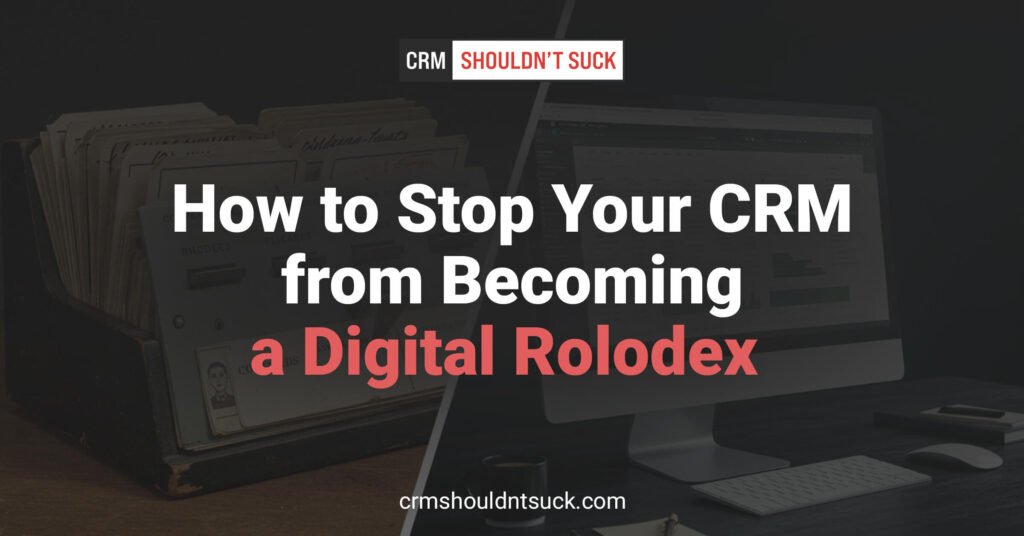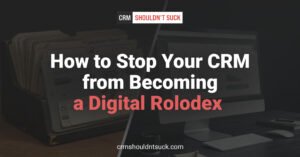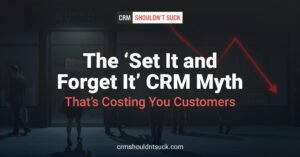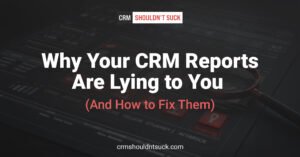The Frustration of an Underutilized CRM
Every sales leader has faced this problem. Your company invested in a CRM with the expectation that it would revolutionize sales, streamline operations, and provide deep customer insights. Fast forward a year, and it has become nothing more than a glorified digital Rolodex. Reps log in, update contacts occasionally, and leadership struggles to pull any meaningful reports. Instead of driving revenue, it is just another tool that no one truly values.
If your CRM is little more than a database of names and email addresses, it is failing you. The question is not whether you have a CRM but whether you are actually leveraging it to enhance sales performance, improve customer relationships, and drive real business outcomes.
Why CRMs Become Passive Databases
Most CRMs do not start as underutilized contact repositories. They become that way because of poor implementation, lack of adoption, and an unclear strategy for how the CRM should support revenue growth. Here are the key reasons CRMs fail to deliver value:
- No Clear Use Case – If sales reps do not see how the CRM makes their jobs easier, they will not use it effectively. CRMs that lack defined workflows for lead tracking, follow-ups, and pipeline management become stagnant.
- Manual Data Entry is a Chore – When sales teams feel like updating the CRM is more work than it is worth, they will avoid it. If your CRM is not reducing admin work, it is just creating frustration.
- Lack of Integration with Other Tools – A CRM that does not seamlessly connect with email, marketing automation, and business intelligence tools forces users to jump between platforms, reducing efficiency.
- Weak Reporting and Insights – If leadership cannot pull meaningful reports on pipeline health, sales velocity, and customer engagement, the CRM is failing as a decision-making tool.
- No Accountability for Usage – Sales teams will only use the CRM if leadership enforces its importance. Without accountability, adoption will remain low.
How to Transform Your CRM into a Revenue-Driving Machine
If your CRM is stuck in digital Rolodex mode, it is time to fix it. Here is how to turn it into a strategic asset that actually moves the needle for sales.
1. Align CRM Usage with Sales Goals
The CRM should be an integral part of your revenue strategy. Start by defining specific goals tied to CRM usage. These could include:
- Increasing lead conversion rates by tracking follow-ups and nurturing efforts
- Reducing deal cycle times by automating routine tasks
- Improving forecast accuracy by ensuring real-time pipeline visibility
When sales teams see the CRM as a tool for winning more business, they will use it more effectively.
2. Automate Repetitive Tasks
Sales reps should spend time selling, not entering data. Automate key processes such as:
- Logging emails and call notes directly into the CRM
- Setting follow-up reminders based on prospect activity
- Updating deal stages automatically as actions are completed
- Assigning leads to the right rep based on predefined rules
A CRM should reduce administrative work, not add to it. The easier it is to use, the more it will be used.
3. Provide Actionable Insights, Not Just Data
Raw data is not valuable unless it is turned into insights. Instead of just collecting contact details, your CRM should help answer:
- Which deals are most likely to close this quarter?
- Which accounts are at risk of churn?
- Which sales activities are driving the highest ROI?
Dashboards and reports should provide clear, actionable intelligence that sales leaders and reps can use to make better decisions.
4. Integrate CRM with Key Business Systems
Your CRM should not exist in isolation. Connect it with:
- Email and calendar systems to track communication
- Marketing automation to sync lead activity and engagement
- ERP or billing systems to see customer history and purchasing trends
When the CRM becomes the single source of truth, it drives more value across the organization.
5. Make CRM Usage Non-Negotiable
Sales teams must see CRM adoption as a requirement, not an option. This means:
- Holding sales reps accountable for keeping pipeline data up to date
- Running all sales meetings based on CRM data rather than spreadsheets
- Rewarding reps who use the CRM effectively
When leadership makes it clear that the CRM is essential to sales success, adoption follows.
The Cost of Keeping a Bad CRM
A CRM that is just a digital Rolodex is worse than useless—it is actively costing you money. Poor data quality leads to bad forecasting, missed follow-ups, and lost deals. Low adoption means leadership lacks the visibility needed to coach reps effectively. And when sales teams do not trust the CRM, they fall back on inefficient, manual processes that slow down revenue growth.
By transforming your CRM into a tool that actively supports sales performance, you are not just making life easier for your team—you are unlocking revenue potential that was previously hidden in bad data and missed opportunities.
Take Action Now
If your CRM is failing, do not accept the status quo. Define its role in your sales strategy, streamline its workflows, and ensure your team is using it to its full potential. A great CRM should be the engine of your sales operation, not a passive database.
Start today by identifying the biggest roadblocks in your CRM and implementing these steps to fix them. The sooner you turn your CRM into a revenue-generating tool, the faster you will see tangible results in pipeline performance, deal velocity, and overall sales success.



